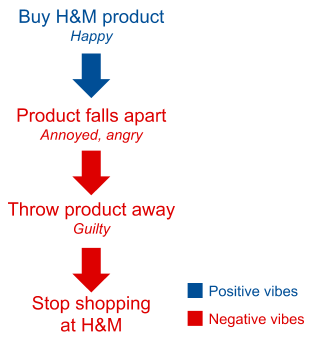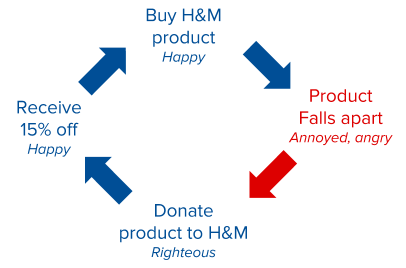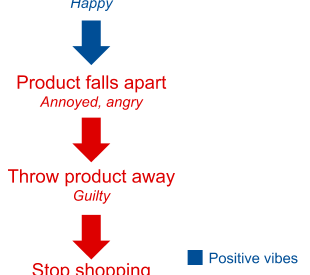For the last few years, H&M has publicized their clothing recycling program with their edgy ?Bring It? campaign. One commercial is narrated by a raspy-voiced woman giving a breathless, poetic list of the types of unwanted clothing they accept. The montage of young people in the super fun (yet clothing-ruining) chaos of everyday life is shot in the shallow focus, desaturated style of a heavily filtered Instagram post. Nods to millennial values such as acceptance of gender fluidity, experiences over things, and an embrace of racial and cultural diversity complete the picture.
The message of this ad? Encouraging us to drop off old clothing to be recycled in exchange for a 15% off H&M coupon. But let?s not be fooled so easily. Don?t forget that H&M is a clothing retailer. The aim of this campaign, and their recycling program in general, is not to work towards a solution to the incredible wastefulness of the clothing industry but to give customers a way to feel morally righteous about buying more than what they need and treating clothing as disposable.
H&M?s sustainability efforts are somewhat ironic considering their business model is not just unsustainable at present: it?s wasteful by design. This is the DNA of H&M. The same can be said of Zara, Forever 21, and other companies selling what John Oliver brilliantly referred to as ?suspiciously cheap clothing.? The business model ? massive quantities, quick turnarounds, low prices ? requires cheap, unethical labor and results in poor quality.
None of that changes with the money H&M is plowing into their green campaigns and research into sustainable solutions to textile waste. Unless the core raison d?tre of H&M and their fast fashion brethren evolves to be something other than trendy, disposable garments, any sustainability effort is nothing more than a thin veil of tree hugging to disguise their true nature.
H&M stands out from this group because they?ve positioned themselves as leaders in the industry when it comes to sustainability. They?ve poured millions of advertising dollars into their sustainability efforts. While sustainability efforts can be noble, H&M has faced immense criticism for their disposable clothing business model. It?s a PR crisis which they have handled like any company would: ride out the backlash then address the issue enough so the public believes you?ve atoned for your sins.
A few years ago, customer relationships with H&M were on the path to looking something like the below chart. Losing customers loses money, so they had to correct the points in the process where customers experience negative feelings in order to keep those customers coming back.

They could have improved the quality to solve the root issue of their items falling apart, but that would have raised prices. So how to improve customer vibes without actually improving what you?re selling? Make them feel good about buying a cheap product. They reengineered the relationship:

There?s a valid argument to be made that if customer feedback results in the company doing something good for the world then that?s a positive outcome. But it?s not clear that this program is actually doing good for the world. H&M?s says (often) that nothing you donate will go to waste. What they mean is that they don?t directly throw anything into a landfill, which are not the same thing.
There are three general uses for what they collect: 60% of what is donated is still wearable and gets donated to second hand clothing charities, most of what?s left is turned into scrap fabric like cleaning cloths. These outlets for the immense clothing overflow have their own drawbacks. Clothing donations have destroyed the textile industry in parts of Africa to the point that some countries have considered banning donations. The clothes are eventually thrown away after their second life anyway. Cleaning cloths sent to places like auto shops are also thrown away after use.
But what about the recycling part of all this? Only 0.1% of what is donated is woven into a new material. It?s also not as perfectly green as H&M?s advertising suggests because a garment can only stand to be composed of a maximum of 20% recycled fibers without falling apart, so virgin fibers are still required.
The advertised goal of H&M?s sustainability efforts is to revolutionize their supply chain into a closed-loop system where textiles are shredded to fibers and rewoven, theoretically eliminating the need for raw materials and keeping textiles out of landfills.
I would argue the goal is simply to keep customers coming back to H&M. This program isn?t good for the environment or the world. It perpetuates the core problem of customers spending less, buying more, and throwing it away by removing the consumerist guilt that goes along with it.
I don?t buy it. Literally.


